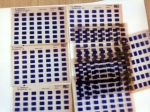
Microform* Reader Printer
While retrieving items from the book store, I spied our microfiche-reader-printer, squirreled away in a corner, hemmed in by a photocopier and other large objects. I’ve passed it hundreds of times in the last few years, without mentally registering that it was there. How the mighty have fallen! In days gone by, this proud machine had a large office all to itself and was visited several times a day to read and print either microfiche or microfilm.
Discussions and debates about the currency of microform usage can be viewed on the internet and in library periodicals. Cost, preservation, long-term storage safety, upgrading of media, availability of hardware and skilled staff are all elements, argued and counter-argued. I trawled through a few debates, but it reminded me of watching a close game of table tennis, with one professional knocking down another’s argument and vice versa. Others would weigh in to support one or the other. Each argument sounding convincing in its own way, here are but a few of the comments.
- Microfilm incurs film and developing costs, greater than digital storage devices.
- Cheaper storage devices are unreliable.
- Microform is safer for long term storage and preservation.
- Analog is dying.
- Microfilm needs to be transferred to digital
- Metadata may be lost or changed when upgrading.
- New technology has sophisticated methods for transferring data.
- Old hardware takes up too much space.
- Fewer staff have the skills to store microform properly.
New hardware is often heralded as being “The One”, the replacement for paper. That’s what happened in our library in the 1970s, when we received a huge donation of journals on microfiche and film. The word was, we would have a paperless library within ten years. A refrain echoed in today’s digital age. Books are dead! Paper has been around for a thousand years, in spite of different media formats. Will it be around for another thousand? What do you think?
Unlike newspaper or government libraries, our microform collection bit the dust some time ago. I’m sure I was the last person to actually print from it, and that was at least eight years ago. The toner was exceptionally expensive and the copies weren’t of high quality.
Still capable of being used to read microfiche, the print facility is no longer required. Waiting for rescue, “baby” sits in the corner hoping that a “Patrick Swayze” will take notice.
Microform* see Wikipedia site for more information, http://en.wikipedia.org/wiki/Microform



You must be logged in to post a comment.